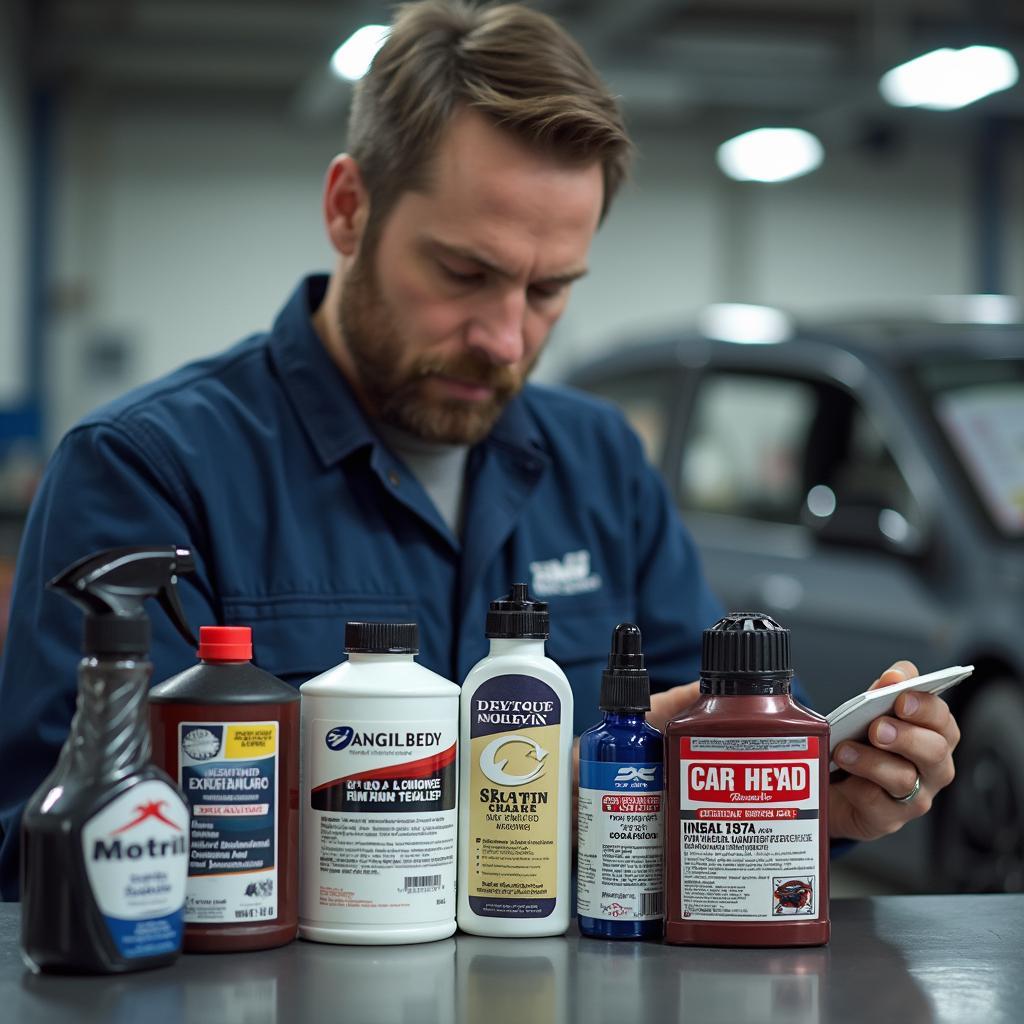Car body repair solvent is a crucial component in the automotive repair industry, used to effectively remove unwanted substances and prepare surfaces for repairs. From minor scratches to significant collision damage, the right solvent ensures a smooth and flawless finish. This comprehensive guide delves into the different types of car body repair solvents, their applications, safety precautions, and expert tips for achieving professional-grade results.
Understanding Car Body Repair Solvents
Car body repair solvents are specialized chemical formulations designed to dissolve and remove substances like grease, oil, wax, silicone, and adhesive residues from car body surfaces. They are essential for preparing the area before applying primers, paints, and other coatings.
Types of Car Body Repair Solvents and Their Applications
1. Wax and Grease Removers
These solvents are formulated to dissolve and remove wax, grease, and other oily contaminants from car body panels. They are crucial for ensuring proper adhesion of primers and paints, as any residue can lead to fish eyes and other paint defects.
2. Silicone Removers
Silicone contamination can cause significant problems with paint adhesion, leading to craters and fisheyes. Silicone removers effectively break down silicone residues, ensuring a clean surface for subsequent coatings.
3. Adhesive Removers
Adhesive removers are specifically designed to loosen and remove tapes, adhesives, and their residues from car bodies. They come in different strengths depending on the type of adhesive being removed.
4. Panel Wipe
Often used as a final cleaning step before painting, panel wipe removes dust, lint, and any remaining traces of solvents or contaminants. It ensures a pristine surface for optimal paint adhesion.
Importance of Choosing the Right Solvent
Using the correct car body repair solvent is crucial for achieving a professional finish. Using the wrong solvent can damage the surface, compromise the adhesion of subsequent coatings, and lead to costly rework.
Safety Precautions When Using Car Body Repair Solvents
Car body repair solvents are flammable and can be harmful if not handled properly. Always follow these safety guidelines:
- Work in a well-ventilated area.
- Wear appropriate personal protective equipment (PPE), including gloves, safety glasses, and a respirator mask.
- Keep solvents away from open flames and sparks.
- Store solvents in their original containers and in a cool, dry place.
- Dispose of solvents and rags properly according to local regulations.
Tips for Effective Solvent Application
- Always test the solvent on an inconspicuous area first to ensure compatibility with the surface.
- Apply the solvent with a clean, lint-free cloth.
- Work in small sections, ensuring the solvent has time to dissolve the contaminant.
- Use multiple clean cloths to avoid reintroducing contaminants to the surface.
- Allow the solvent to evaporate completely before proceeding with the next step.
Expert Insights
“Choosing the right solvent and using it correctly is just as important as any other step in the car body repair process,” says John Smith, an experienced automotive paint specialist with over 20 years of experience. “Taking shortcuts with solvent selection can lead to long-term problems with paint adhesion and finish quality.”
Conclusion
Car body repair solvents are essential tools for achieving a professional and long-lasting finish. By understanding the different types, their applications, and following safety precautions, both professionals and DIY enthusiasts can achieve excellent results. Remember, using the right solvent and applying it correctly ensures proper adhesion of primers, paints, and other coatings, leading to a flawless and durable repair.
FAQs
Q: Can I use lacquer thinner as a car body repair solvent?
A: Lacquer thinner is a strong solvent and should not be used as a general-purpose car body repair solvent. It can damage certain plastics and rubber components.
Q: What should I do if I get car body repair solvent on my skin?
A: Immediately flush the affected area with plenty of soap and water. Seek medical attention if irritation persists.
Q: Can I dispose of car body repair solvents down the drain?
A: No, never dispose of solvents down the drain. Contact your local waste management authority for proper disposal instructions.
Need help with a car body epoxy repair kit? Learn more about car body epoxy repair kits car body epoxy repair kit on our website.
Find out more about car body repair materials in the UK car body repair materials uk.
Want to know about the risks associated with car body repair? Check out a typical risk assessment for a car body repair garage.
Are you looking for information on car body repair using BC paint? Read more about bc paint car body repair.
Get detailed information about car body repairs at ash stations by visiting our page on car body repairs ash station.
Need further assistance? Contact us on WhatsApp: +1(641)206-8880, or Email: [email protected]. Our team is available 24/7 to assist you.



